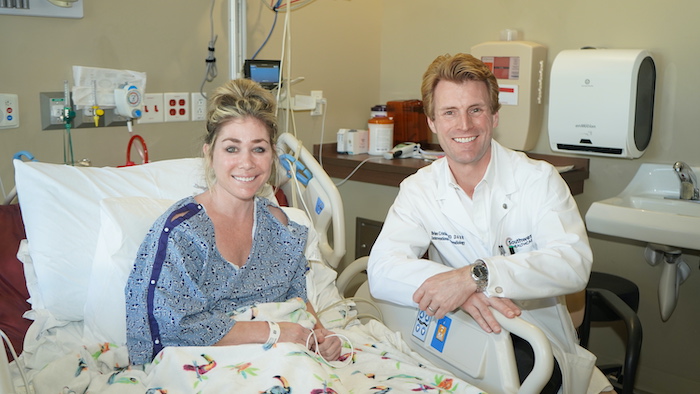Think You’re Too Young to Have a Stroke? Think Again.

Danae Wilson was enjoying a healthy, active life without any significant medical issues. Before the waning days of summer 2024, if you asked her to list the symptoms of stroke at just age 35, she wouldn’t know where to start.
Danae injured her neck in late August while working at a local winery. She didn’t think much of it, but a few days later, she began experiencing unusual symptoms that she attributed to food poisoning before later falling, hitting her head and losing consciousness in her bathroom. Her husband, Charles, was asleep on the couch downstairs.
Danae thought she had symptoms of a concussion. She was experiencing dizziness, nausea, cold sweats, vomiting and slurred speech. When Charles went up to their bedroom at about 4:30 a.m., Danae struggled to tell him about her head trauma. “I couldn't really talk,” she remembers. Charles left for work — worried — and constantly texted her.
At around 6 a.m., Danae called Charles to tell him she could not read his texts. “I was slurring my words and he couldn’t make sense of what I was saying,” she says. “He told me to stand up and look at my eyes in the mirror. I couldn’t see my reflection.”
Charles headed straight home, staying on the phone with his wife until he arrived to take her to Southwest Healthcare Temecula Valley Hospital (TVH).
“Luckily, Charles had the intuition I lacked. By the time he got home, I was dead weight. I couldn’t walk,” she recalls with emotion. “He saved my life.”
Quick, Life-Saving Action
When the Wilsons reached the TVH ER, staff took one look at Danae and knew it was no concussion. She was experiencing a stroke.
“I was terrified. I didn’t understand why the staff was moving me through triage so quickly,” Danae explains. “From when Charles picked me up to the time that I was in surgery was probably only about 45 minutes.”
Brian Cristiano, MD, an Endovascular Surgical Neuroradiologist and acute stroke intervention specialist at TVH, wasted no time.
“Danae’s symptoms were immediately recognized by emergency room staff as a possible stroke and she was evaluated in accordance with our established treatment protocol for immediate intervention,” Dr. Cristiano recalls. “Neurologist Dr. Rabia Yasin, an expert who specializes in the medical evaluation and treatment of stroke, examined the patient with ED staff and confirmed signs of brainstem ischemia (insufficient blood flow). Danae was not a candidate for medical stroke intervention because her symptoms had started over four hours prior. However, surgical stroke intervention was still a possibility. A CT angiogram was subsequently obtained and showed an injury to a critical artery in her neck. A blood clot had formed at the site of injury and migrated to the head, resulting in an occlusion [blockage] in the basilar artery, which is the main artery in the back of the head that feeds blood to vital brain structures, including the brainstem.”
Danae’s condition was life-threatening, and she needed endovascular surgery — fast. The procedure is called percutaneous mechanical thrombectomy, a minimally invasive procedure designed to remove blood clots in arteries, including in the brain through the natural arteries of the body and restore normal blood flow to the affected tissues and organs.
Danae was placed under anesthesia before Dr. Cristiano placed a small vascular sheath in a main artery of her right leg. He then inserted a flexible catheter through the sheath under image guidance to the level of occlusion and removed the blood clot. Dr. Cristiano removed the blockage in the basilar artery, restoring normal blood flow to Danae’s brain within minutes of the procedure start.
A Brave Road to Recovery
Due to her condition, Danae is unsure when she first heard the word “stroke” during her ordeal.
“It was all such a shock. I thought I just fell down,” she recalls. “The thought that I had a stroke didn’t even cross my mind.”
Danae spent four days at TVH under close observation. She began anticoagulant (anti-clotting) therapy to prevent additional blood clots (arterial thromboemboli) from forming in the injured neck vessel and to allow that vessel to heal without causing additional strokes.
“Danae’s story demonstrates that acute stroke can affect patients of all ages,” Dr. Cristiano states. “Due to prompt recognition of her symptoms by the medical staff at Temecula Valley Hospital and the expertise of the neurovascular and intensive care teams, an excellent outcome was obtained.”
Understandably, Danae becomes emotional when she recounts the story of her stroke. “These healthcare professionals are amazing and they know exactly what needs to be done,” she expresses. “They are efficient and made me feel so comfortable.”
While Danae’s dance background helped her quickly regain her balance, she still required outpatient rehabilitation to regain her independence.
“It’s been a process relearning how to drive and how to write. I’m thankful my speech came back pretty quickly,” Danae says. “When you wake up one day and you can’t do what you used to do, it’s really terrifying.”
Today, she is back to work and feeling great. “It’s such a gift,” Danae says. “I wish I could call out every person by their name.”
Every case is unique and individual results vary. The first step to a good outcome after a stroke is early recognition. If you or a loved one are or may be experiencing symptoms of a stroke such as sudden loss of balance, weakness, numbness, facial asymmetry, or inability to speak immediately call 911.
